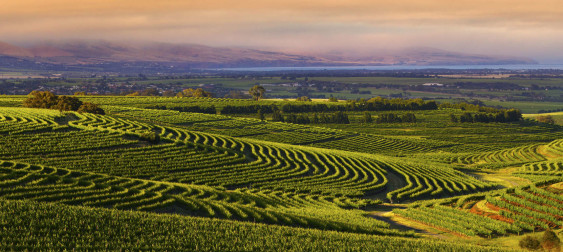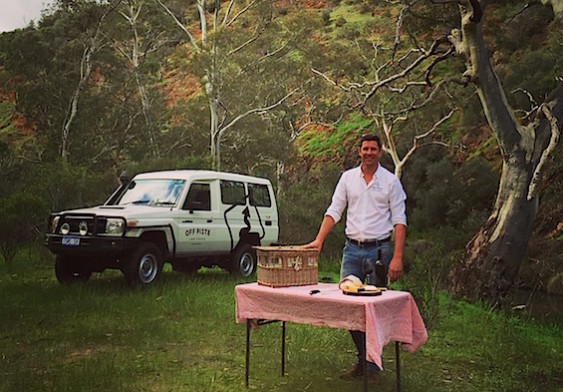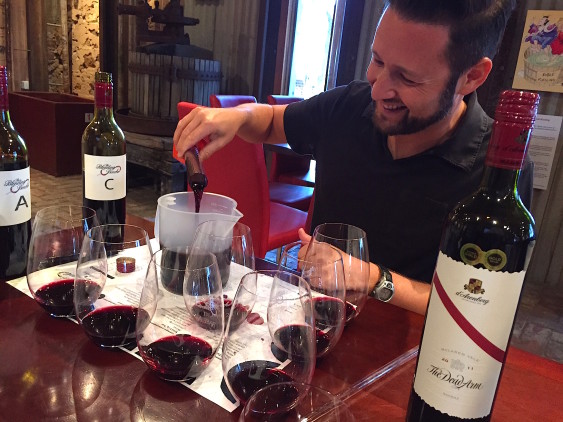Since it’s getting close to harvest time in the Southern Hemisphere, I thought for today’s post, we’d head back “Down Unda” to talk about some of the ways they blend wines in Australia.
Although in the U.S., we tend to label our wines by the dominant grape variety used to make them, in other parts of the world, it’s much more common to find blends. Even most champagnes are made from a blend of Chardonnay, Pinot Noir and Pinot Meunier, for example, and red Bordeaux wines can be made from five grape varieties.

I headed to South Australia’s McLaren Vale to learn about blending.
In fact, depending on the region and the grape varieties grown there, the blending process can be the most important step in winemaking. That’s both because each variety brings unique flavors and characteristics to the finished wine, as well as the difficulty the winemaker faces in finding the right balance among them all. But wines can also be made of blends of the same grape variety, just from different plots or parcels of land, to achieve a better expression of that variety. In short, it takes a whole lot of tasting over a whole lot of time to blend the right wine you want.
On my last trip to Australia, I got to take a bit more of a hands-on look at the blending process during a visit to South Australia’s McLaren Vale wine region. It’s just about 45 minutes south of Adelaide along the coast, and is known for producing some spectacular Shirazes as well as full-bodied Cabernet Sauvignons and Chardonnays.
During a day out with Off Piste Tours, we stopped in at one of McLaren Vale’s most famous wineries, d’Arenberg. d’Arenberg was established back in 1912 by a businessman and racehorse breeder named Joseph Rowe Osborn, who was actually a tee-totaler himself! He used the winnings from his racehorses, including a famous steed named Footbolt (after whom one of their flagship wines is named), to buy the original vineyards (some of which date to 1838).
At first, they sold grapes to other wineries, but built a winery in 1927. Osborn’s grandson, Francis (who is known as d’Arry) was the one who actually changed the winery’s name to d’Arenberg in honor of his late mother, Helena d’Arenberg, and put a recognizable red stripe on the label as a reference to the striped ties he wore at his alma mater, Prince Alfred College.

Off Piste Tours took me on my McLaren Vale adventure.
The winery is currently run by the fourth generation of the family out of an old homestead that dates back over 130 years, and if you’re lucky, you might just get to see d’Arry regaling lunchtime visitors with tales of the winery’s past.
One of d’Arenberg’s most famous wines is called Dead Arm. Fortunately (or unfortunately, if you like sitting around a campfire), there’s not ghost story behind the name. “Joseph Osborn and the Dead Arm,”…spooky! No, instead, the wine gets its name from the fact that the vines used to make it contracted a fungal disease called Eutypa Lata that slowly kills one of the branches on a grape vine. This doesn’t kill the vine itself, but instead means that the clusters produced on the living arm are more intense and concentrated.

I’m not sure my blend came out as well as Dead Arm usually does!
Dead Arm is made from a blend of Shiraz grapes from a few parcels on the d’Arenberg property that have been infected with the disease and are thus prized for their flavors. Best of all, it’s just about $65 AUD (but retails for about $40-$50 in the U.S. depending on where you shop). No wonder the wine is so popular!
During my visit, I learned all about d’Arenberg’s history and the wines they make from John Paschke at the “cellar door,” as they call tasting rooms in Australia. He walked me through the “Tasting Bench” experience where I was able to taste wines from various vineyard plots (including one planted in 1898 – so hey, it was there when the U.S.S. Maine exploded in Havana Harbor setting off the Spanish American War!) and make my own blend. Here is how the experience went:
I was looking for the right blend of fruitiness (which distinguishes Shiraz from this area) but also the refinement that comes from old vines and barrel aging. I’m not sure I succeeded, but I tried “Eric’s Arm” with Australian friends a few days later, and we finished it rather quickly!
Meanwhile, if you want to visit d’Arenberg and try the same blending experience for yourself, you can book it here. And if you’d rather just let the professionals do the work, you can purchase Dead Arm here.

